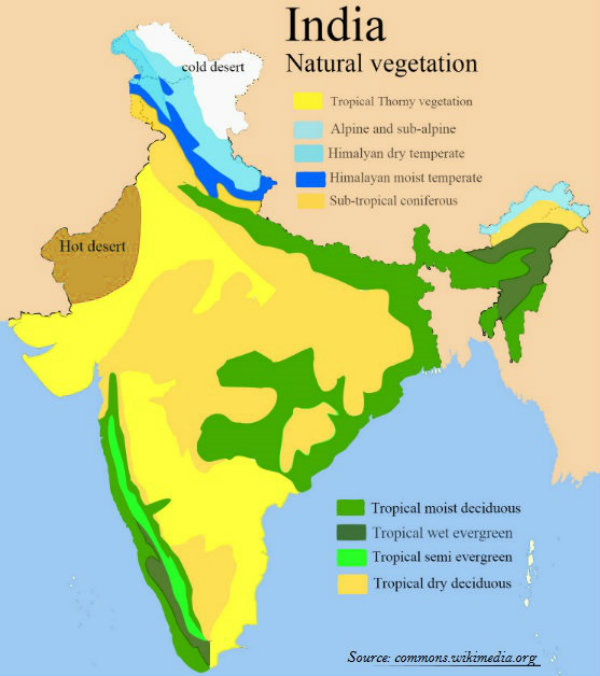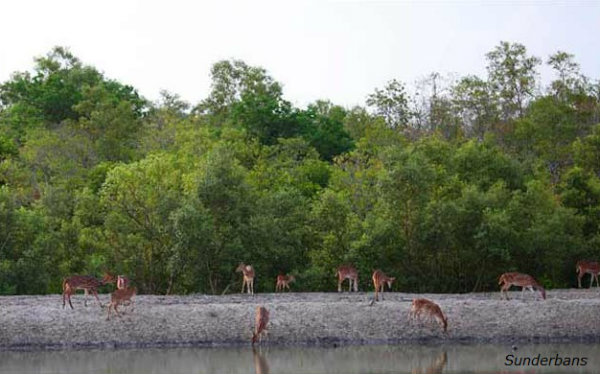- Natural vegetation refers to a plant community that has been left undisturbed over a long period of time.
Classification of Vegetation
- Based on climatic conditions, forests are divided into categories. They are −
- Tropical Evergreen and Semi Evergreen forests
- Tropical Deciduous forests
- Tropical Thorn forests
- Montane forests
- Littoral and Swamp forests
Tropical Evergreen Forests
- Tropical evergreen forests are found in the regions that receive annual precipitation of over 200 cm and mean annual temperature above $22^{\circ}C$.
- Tropical evergreen forests are found in the western slope of the Western Ghats, hills of the northeastern region, and the Andaman and Nicobar Islands.
- In tropical evergreen forests, trees reach great heights, i.e., up to 60 m or even above. And, largely these trees do not have fixed time to shed their leaves.
- Major examples of evergreen forests are rosewood, mahogany, aini, ebony, etc.
Semi-evergreen Forests
- Semi-evergreen forests are a mixture of evergreen and moist deciduous trees, found in the regions that receive less precipitation than the evergreen forests.
- Main species of semi-evergreen forests are white cedar, hillock, and kail.
Tropical Deciduous Forests
- Tropical Deciduous Forests are the most widespread forests of India and are popularly as Monsoon Forests.
- Tropical deciduous forests are found in the regions, which receive rainfall between 70 and 200 cm.
- Tropical deciduous forests are further categorized as the Moist deciduous forests and Dry deciduous forest.

- The moist deciduous forests are found in the regions, which record rainfall between 100 and 200 cm.
- The moist deciduous forests are found along the foothills of the Himalayas, eastern slopes of the Western Ghats, and Odisha.
- Teak, sal, shisham, hurra, mahua, amla, semul, kusum, and sandalwood etc. are the main species of the moist deciduous forests.
- Dry deciduous forests are found in the regions that receive precipitation between 70 and 100 cm.
- As the dry season begins, the trees of deciduous forests shed their leaves completely.
- Tendu, palas, amaltas, bel, khair, axlewood, etc. are the major trees of dry deciduous forests.
Tropical Thorn Forests
- Tropical thorn forests are found in the areas, which receive rainfall less than 50 cm.
- Tropical thorn forests are found in the areas of south west Punjab, Haryana, Rajasthan, Gujarat, Madhya Pradesh, and Uttar Pradesh.
- Babool, ber, and wild date palm, khair, neem, khejri, palas, etc. are the important species of tropical thorn forests.
Mountain Forests
- Mountain forests in India are normally classified into two types, i.e. the northern mountain forests and the southern mountain forests.
- Deciduous forests are found in the foothills of the Himalayas.
- Temperate forests found between an altitude of 1,000 and 2,000 m.
- In the higher hill ranges of northeastern India; for example, hilly areas of West Bengal and Uttaranchal, evergreen broad leaf trees such as oak and chestnut are predominant.
- Chir, deodar, pine, etc. are the important species of temperate forests.
- Between 3,000 and 4,000 m, Silver firs, junipers, pines, birch, and rhododendrons, etc. are found.
- However, at higher altitude, the tundra vegetation is found and major species are mosses and lichens.
- At a higher altitude, the southern mountain forests largely belong to the temperate type, which are locally known as ‘Sholas’ in the Nilgiris, Anaimalai, and Palani hills. Some of the trees of economic significance include magnolia, laurel, cinchona, and wattle.
Littoral and Swamp Forests
- India is rich in Littoral and Swamp Forests.
- Chilika Lake (in Odisha) and Keoladeo National Park (in Bharatpur, Rajasthan) are protected as water-fowl habitats under the Convention of Wetlands of International Importance (i.e. Ramsar Convention).
- Mangrove grows along the coasts in the salt marshes, tidal creeks, mud flats, and estuaries; and, it has a number of salt-tolerant species of plants.
- In India, the mangrove forests spread over 6,740 sq. km, which is 7% of the world’s mangrove forests
- Mangroves are largely found in the Andaman and Nicobar Islands and the Sunderbans of West Bengal.


No comments:
Post a Comment